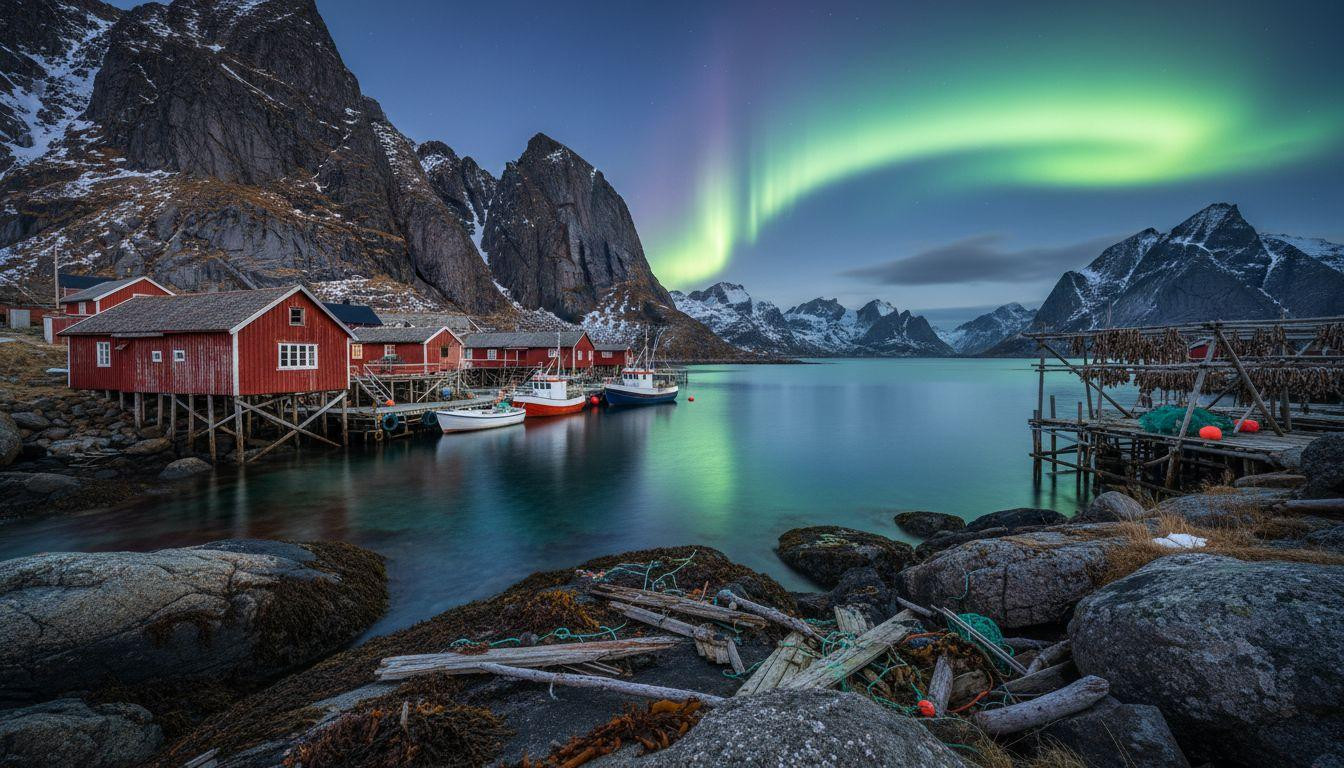Dawn breaks at 9:47 AM in Reine, where morning mist rises from the Reinefjord while red wooden cabins catch first light beneath granite peaks. Steam rises from coffee in a village of 300 residents preparing for another November day. Three months ago, this Lofoten fishing harbor buzzed with midnight sun seekers. Now, as polar night descends and northern lights begin their celestial dance, the aurora paints these centuries-old rorbuer salmon-pink against turquoise fjord waters.
This isn’t Tromsø’s commercialized light-chasing crowds 4 hours north. This is Norway’s most photogenic secret: where Arctic fishing traditions survive beneath some of Earth’s most dramatic skies.
Where Lofoten’s dramatic geography meets polar light
Reine occupies a narrow strip of land on Moskenesøya island, 67.9°N above the Arctic Circle in Norway’s Nordland County. The village sits at sea level, surrounded by peaks rising 1,300-2,000 feet directly from fjord waters. Reinebringen’s 1,470-foot summit offers panoramic views requiring a steep 1-hour climb up 2,468 stone steps.
Located approximately 32 miles from Leknes Airport (1-hour drive via E10), Reine remains accessible yet isolated: 4,500-5,000 miles from major US cities, requiring Oslo connections. The journey involves 7-9 hours transatlantic, 2.5 hours Oslo-Leknes, then road transfer. November temperatures hover 28-36°F, with 18 hours of darkness perfect for aurora hunting.
The Gulf Stream keeps waters ice-free year-round. This maintains the fishing economy that built this place centuries ago.
The pink northern lights phenomenon above red rorbuer
When aurora borealis transforms fishing cabins
Between September and March, Reine’s clear Arctic skies reveal northern lights in vivid greens, pinks, and purples. The village’s iconic red wooden rorbuer (traditional fishermen’s cabins on stilts) glow salmon-pink when aurora light reflects off their weathered walls. Local tourism boards confirm November offers 18-22 clear nights out of 30 for aurora viewing.
The distinctive pink glow occurs due to unique light interaction: northern lights emit primarily green (557.7nm) and red (630nm) wavelengths. Traditional red rorbuer cabins use Falun red paint containing iron oxide. At night, the red auroral component reflects off the iron oxide pigment, creating that magical pink effect you only see in authentic fishing villages.
Centuries of fishing heritage unchanged
Reine’s 900+ year fishing history remains visible: cod drying racks line harbors, traditional boat houses cluster at water’s edge, and stockfish production continues using methods unchanged since Viking times. First mentioned in historical records in 1436, the village serves as working harbor first, tourist destination second. This authenticity draws photographers seeking genuine Arctic coastal life beneath dramatic peaks.
85% of Reine’s rorbuer are protected heritage structures. Built on stilts to protect from flooding and allow boat access during high tide, these pine wood cabins with tarred exteriors represent centuries of adaptation to harsh Arctic conditions.
Experiencing Reine’s Arctic coastal life
Beyond aurora hunting
The Reinebringen hike (1,470 feet elevation gain, completed with 2,468 stone steps in 2023) rewards with sweeping views of red cabins, turquoise fjords, and surrounding peaks. Best attempted in daylight hours given November’s limited sun. The nearby village of Flåm offers a complementary fjord railway experience for those seeking additional Norwegian adventures.
Kayaking among rorbuer offers water-level perspectives of mountains rising vertically. The E10 road connects to neighboring fishing villages like Hamnøy and Sakrisøy for extended exploration. Winter visitors can attempt ice climbing on frozen waterfalls or join guided snowshoe treks across coastal mountains.
Arctic gastronomy and traditional lodging
Local restaurants serve stockfish (air-dried cod), Arctic char, and reindeer meat. Hearty dishes reflecting harsh climate cost $25-50 at village establishments. Several historic rorbuer function as guesthouses ($245-285/night), offering authentic stays in renovated fishing cabins with modern heating. Fresh seafood dominates menus, with cloudberries providing rare Arctic dessert options.
Traditional knitted wool garments and carved wooden items fill small artisan shops. The smell of stockfish and wood smoke (locals call it “the smell of money”) creates an authentic sensory experience no Instagram filter can capture.
The overlooked alternative to Tromsø’s crowds
While Tromsø corrals northern lights tourists into commercial tours and urban light pollution, Reine offers unmediated access to auroras above authentic fishing heritage. The village welcomes 185,000 annual visitors versus Tromsø’s 950,000, maintaining tranquility rare in Arctic destinations. Costs run 25% lower: accommodation $245-285 vs Tromsø’s $300-400, meals $25-50 vs $40-65.
National Geographic Traveler’s October 2025 feature called Reine “an overlooked jewel for Arctic photography and serenity.” The contrast is profound: Reine preserves working village rhythms beneath spectacular skies, while larger destinations sacrifice authenticity for tourism infrastructure. Here, 300 residents still fish beneath the same mountains that sheltered their ancestors. For those seeking salmon-pink midnight sun experiences, Reine offers complementary seasonal magic.
Your questions about Reine answered
When should I visit for northern lights?
September through March offers best aurora chances, with November-February providing longest darkness (14-18 hours). Peak season is winter, but shoulder months (September, March) balance light opportunities with milder temperatures and fewer crowds. Summer brings midnight sun instead, a completely different but equally dramatic experience that parallels other overlooked coastal destinations worldwide.
How much does a Reine visit cost?
Budget $245-285/night accommodation in guesthouses or rorbuer, $25-50/meal at local restaurants, $135-160 for northern lights tours, $50-100 for guided hikes. Total daily cost: $350-450, roughly 25-30% below Tromsø. Round-trip flights from US East Coast via Oslo: $800-1,200 economy. Car rental from Leknes: $125/day.
How does Reine compare to other fjord destinations?
Reine offers more dramatic mountain-fjord landscapes than Iceland’s flatter coastal areas, with authentic fishing village setting versus Iceland’s tourist-focused infrastructure. Both have excellent aurora visibility, but Reine maintains working community character. Compared to New Zealand’s dramatic fjords, Reine provides Arctic rather than temperate wilderness experiences.
At 11:28 PM, pink aurora ribbons unfurl above Reinefjord while red cabins glow salmon beneath dark peaks. A fisherman checks his boat for tomorrow’s 4 AM departure. The northern lights dance, indifferent to cameras. This is Reine’s gift: celestial theater above timeless Arctic rhythms, where 300 souls guard Norway’s most dramatic secret.
